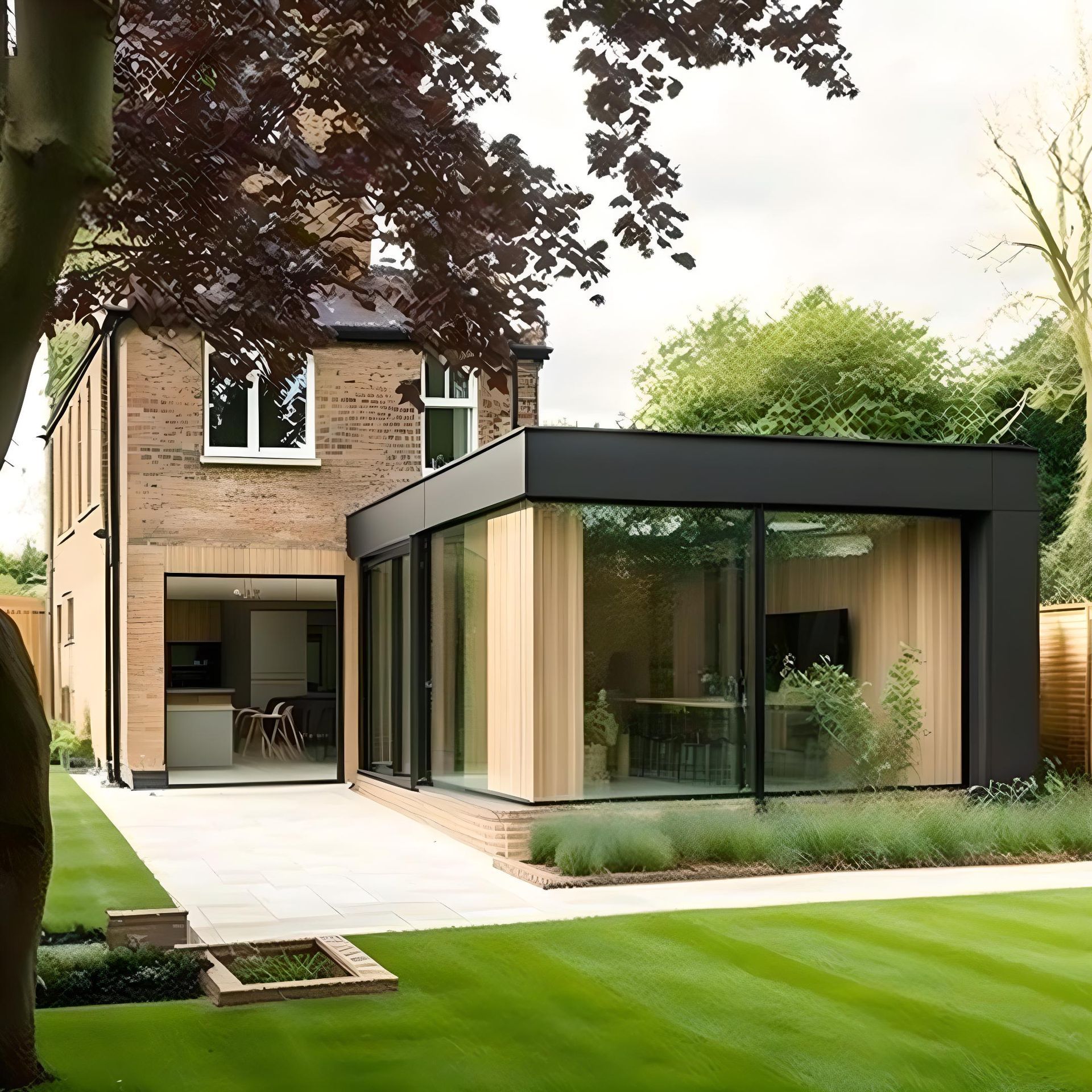Maximise Your Home's Potential with a Stylish Velux Loft Conversion: The Ultimate Guide
Velux is a window brand but has become a catch-all term for roof windows that fit the angle of the roof. Roof windows open outwards towards a horizontal angle and can be installed in sloping roofs.
One of the main uses of a Velux window is in a loft conversion. Lofts can be converted without making structural modifications to the roof itself, and light can be provided by a Velux or roof window, which is fitted into the sloping roof.
Velux loft conversions are often viewed as their own class alongside Dormer and Mansard loft conversions, which both modify the roof. Since Velux conversions don’t modify the roof except to install the window, they’re more likely to fall under Permitted Development or receive Planning Permission. They’re also considerably cheaper than other types of loft conversions.
This is a guide to Velux window loft conversions.
Velux loft conversions
A velux window loft conversion is the ideal way to add additional living space to your home without the need for a full-scale conversion.
Velux windows are becoming increasingly popular in loft conversions due to their ease of installation, low cost and excellent energy efficiency. In addition, they provide a great way to add natural light and ventilation to a loft space because of their above-average size.
A Velux loft conversion is the most cost-effective and simplest type of loft conversion. It involves installing windows into the roof, making the space habitable by adding a staircase, insulation, plumbing, electricity, and windows. This type of conversion does not usually require Planning Permission, although Building Regulations still apply.
Velux conversions are ideal for lofts with plenty of vertical space or when only a single room is needed. However, homes with shallow roofs may not have enough space for a Velux conversion.
Is my home suitable for a Velux loft conversion?
Not all houses are suitable for Velux loft conversions. If your roof is below 2.2m at the highest point, then you won’t be able to install any loft conversions without raising the height of the roof, which is a fairly major undertaking.
Most loft converters won’t recommend a loft conversion if the roof is 2.4m or lower. There simply won’t be enough room. There are various ways of increasing roof height, such as dropping the floor or lifting the roof. If you’re raising the roof, you might well go all-in with a dormer or Mansard conversion.
How old is your home?
Contrary to what many assume to be the case, older homes built before the 1960s tend to have stronger timber-frame roofs that are more suitable for loft conversions.
Newer roofs are generally factory-made and tend to be weaker, so they often require structural support work. However, this varies from house to house, so don’t assume anything.
Moreover, the process of strengthening the roof and floor is fairly straightforward these days.
The benefits of Velux loft conversions
A Velux loft conversion is an increasingly popular way to take advantage of unused attic space.
This type of conversion is efficient, affordable, and provides a great way to add more space and storage to a home without costly roof modifications. The affordability of this type of conversion makes it an attractive option for those that want to add a new room to their homes in the simplest way possible.
Simplicity
Velux loft conversions are simpler than dormers or Mansards, but they offer a superb route to loft conversion without major structural works. If you want to add an additional room, office space or similar, then a Velux conversion may easily suffice.
Space-efficient
Not all Velux conversions are small. If you have a large loft space, then you might not need to modify the roof at all to create a very spacious and bright loft conversion. For deep, tall roofs, Velux conversions are both space and cost-efficient.
Cost-effective
Velux conversions can be half the price of an advanced Mansard conversion. In addition, they involve no structural modifications to the roof other than adding the window, which means they’re much cheaper.
Usually fall under Permitted Development
Permitted Development favours loft conversions that don’t alter the roof. A Velux conversion is often suitable when a dormer or Mansard is not. Planning Permission is more likely to be granted on a compact Velux conversion than a large protrusive dormer or sizable Mansard.
How much do Velux loft conversions cost?
Velux loft conversions are cheaper than dormers and Mansards. In 2022 and 2023, you’ll still almost definitely need to budget £30,000 in most parts of the UK, but you’ll be paying some 20% to 40% less than you would for other types of loft conversions.
The average costs of Velux loft conversions in 2022/2023 are as follows:
- 20m2 (1 room) - £12,000 to £35,000
- 30m2 (1 large room) - £15,000 to £38,000
- 48m2 (1 to 2 rooms) - £20,000 to £40,000
- 64m2 (2 large rooms) rooms - £40,000 to £75,000+
Prices will vary, and you’re probably looking at £30,000 to £50,000 for typical projects with VAT.
Using a
professional designs and drawings service like Fast Plans keeps costs down and enables you to shop around multiple contractors to achieve the very best quotes.
What kind of rooms can you build with a Velux loft conversion?
A Velux loft conversion can be used to create a number of different types of rooms, from bedrooms to offices, playrooms and music rooms.
Velux conversions for bedrooms
A bedroom is most definitely the most popular use for a Velux loft conversion. It can be used to add an extra bedroom to a home where space is limited or to create a new room for a new family member. In addition, landlords and landladies can add Velux conversions to their properties to increase rental income.
Adding an extra bedroom to a property always increases its value. Studies show that loft conversions
boost home value by some 20%. You can add en-suites to Velux loft conversions the same as any other type of loft conversion.
Velux conversions for home offices
A Velux loft conversion can create an effective home office. This can be a great solution for those who work from home or need a dedicated study or productivity space away from the rest of the home.
The extra space and natural light provided by the Velux loft conversion make it a great place to be productive and focus on work.
Velux conversions for playrooms and games rooms
A Velux loft conversion can also be used as a playroom, games room or man cave segregated from the rest of the house. Loft conversions are excellent for separating the upstairs from the downstairs and provide privacy and soundproofing from the rest of the house.
Do Velux loft conversions require Planning Permission?
Velux loft conversions are the least likely of any loft conversion to require Planning Permission.
They’re highly likely to fall under Permitted Development Rights (PDRs), which apply to most properties except those on designated land,
which you can read about here. You should always contact the local planning authority to confirm there are no local restrictions.
If you are unsure whether or not your Velux loft conversion will require planning permission, then it is wise to contact your local council planning department for advice. They will be able to provide you with detailed information as to what is required for your particular project.
Here are a few pointers:
Space
The first thing to consider when planning a Velux loft conversion is the amount of space available in the loft. If the loft is too small, then a Planning Application may be required to extend the roof to the minimum 2.2m required.
It is also important to consider the height of the proposed loft conversion. If the proposed loft conversion is higher than the existing ridge height of the existing roof, then planning permission will be required. This isn’t an issue for Velux conversions.
Materials
Some local authorities have restrictions on the type of materials that can be used for the conversion, so it is important to check with the local council for the specific regulations for your area.
No existing additional stories
PDRs don’t apply if there are any pre-existing additional stories. So, if the home has already been extended upwards, you’ll need Planning Permission.
Summary: Velux window loft conversions
Overall, a Velux loft conversion can add additional living space to your home without the outlay of other types of loft conversions.
Homeowners can use Velux conversion to create many different types of rooms, from bedrooms to offices to playrooms and bathrooms, making it a versatile and practical solution for any home.
If you’re looking for a Velux loft conversion,
Fast Plans can produce professional drawings, designs and engineer’s calculations to enable you to shop for the best quotes.
Contact us today to find out how we can help you get
London loft conversion plans off the ground!
Get in touch
It doesn't matter how large or small your project is, or how early in the planning process you are. We can help.
With our vast experience, we deliver both a refreshingly honest approach and great value for money; after all, when it comes to projects as crucial as these, you want to get it right the first time! Our team of experienced and highly qualified architects and designers can bring your home improvement dreams to life.
Request a FREE consultation with our design team
Request your FREE no-obligation proposal

Schedule a Call/Get in Touch Form
We will get back to you as soon as possible.
Please try again later.
Related posts
Our fast and seamless design and planning services have helped thousands of homeowners maximise their living space.
H: M - F / 8am - 5.30pm
Take a Look Around
Service Areas
Social
Fast Plans | All Rights Reserved.


